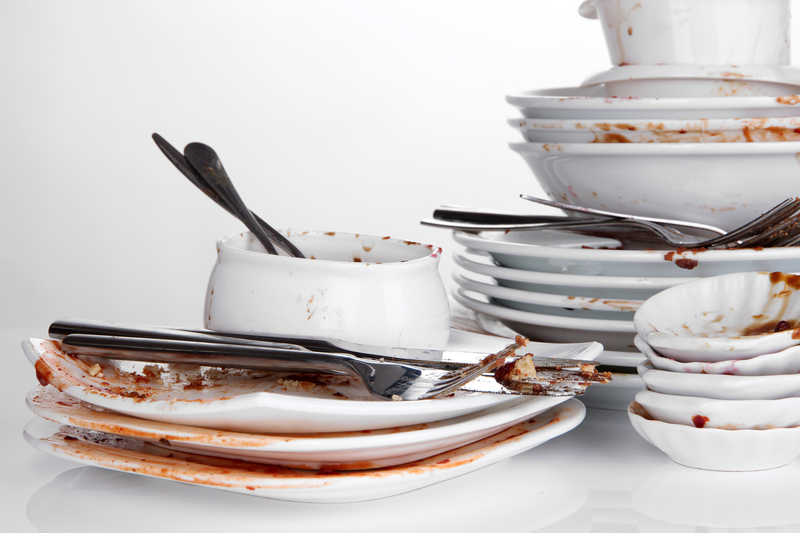Pursue Purity: A Simple Approach to Enamel Oven Tray Cleaning
Posted on 22/05/2025
Pursue Purity: A Simple Approach to Enamel Oven Tray Cleaning
Maintaining enamel oven trays is essential for both the longevity of your cookware and the purity of your meals. Over time, baked-on grease, food residue, and burnt stains can tarnish your oven trays, making them appear unsightly and potentially imparting unwanted flavors to your dishes. Luckily, cleaning enamel oven trays can be straightforward, effective, and safe with the right approach.
Why is It Important to Pursue Purity with Your Enamel Oven Trays?
Enamel oven trays are prized for their durability and non-porous surface. But even the toughest enamel can become stained or etched by stubborn grime. Pursuing purity in your kitchen fosters a cleaner, healthier, and more enjoyable cooking experience for you and your family. Here's why keeping oven trays spotless matters:
- Hygiene: Old food residues can harbor bacteria and mold.
- Flavor Preservation: Burnt-on bits can affect the taste of your next meal.
- Appearance: Clean trays look inviting, rather than unappetizing.
- Lifespan: Regular cleaning extends the life of your enamel bakeware.

The Science Behind Enamel Oven Tray Cleaning
Enamel is a type of glass coating fused onto metal. It forms a hard, smooth, and usually glossy surface that resists most food acids and prevents rust. However, it can be sensitive to abrasive cleaners and sudden temperature changes. Understanding the science behind your tray will help you avoid common cleaning mistakes.
- Non-Stick Properties: Enamel trays are less likely to retain baked-on food, but occasional stubborn residue can occur.
- Scratch Risks: Abrasive tools can thin or damage the enamel, exposing the metal underneath to rust.
- Stain Factors: Acidic and sugary foods, as well as high-heat cooking, can lead to tough stains if not cleaned promptly.
Common Challenges in Cleaning Enamel Oven Trays
No matter how meticulous you are, challenges crop up. Baked-on grease, stubborn carbonized stains, discoloration, and sticky residues are typical examples. If left untreated, these substances become harder to remove and can compromise both purity and function.
Main Culprits:
- Baked-on Oils and Fats
- Burnt Sugar and Caramel
- Charred Food Particles
- Food Dyes and Sauces
A Simple, Step-by-Step Approach to Cleaning Enamel Oven Trays
Let's break down the easiest and most effective approach. The key to maintaining enamel oven tray purity is gentle, consistent care.
1. Preparation: Gather Your Cleaning Supplies
- Soft sponge or cloth
- Baking soda
- White vinegar
- Dish soap
- Warm water
- Optional: Non-abrasive scouring pad, lemon juice, hydrogen peroxide
2. Basic Cleaning
- Allow the enamel oven tray to cool completely.
- Fill the tray with warm, soapy water. Let it soak for 15-30 minutes to loosen any residue.
- Using a soft sponge, gently wipe the surface to remove food particles.
- Rinse thoroughly with warm water and dry with a soft towel.
3. Dealing With Stubborn Stains
- Sprinkle a thick layer of baking soda over the stained areas of the tray.
- Spray or drizzle white vinegar onto the baking soda. The mixture will fizz - this reaction helps lift grime.
- Let the mixture sit for 15-30 minutes. For extra stubborn spots, let it sit even longer or overnight.
- Scrub gently with a non-abrasive pad or cloth.
- Rinse with warm water and dry.
4. Advanced Cleaning for Charred or Greasy Residue
- For burnt-on areas, make a paste from baking soda and a little water. Spread this directly on the stained areas.
- Allow the paste to sit for up to an hour.
- Using a soft cloth or sponge, scrub the stains in a gentle, circular motion.
- Rinse thoroughly and inspect the tray. Repeat as needed.
5. Natural Alternatives & Eco-Friendly Tips
- Lemon juice can also help cut through grease and leave a fresh scent.
- A mixture of hydrogen peroxide and baking soda can tackle the most persistent stains. Let it fizz for up to two hours before scrubbing and rinsing.
- Try to avoid harsh commercial oven cleaners, as they can damage enamel surfaces over time.
Expert Tips for Maintaining Enamel Oven Tray Purity
Keeping your enamel oven trays in pristine condition doesn't have to be a chore. Here are some pro tips to help you preserve their glow and functionality.
- Clean promptly after each use to prevent stubborn build-ups.
- Line trays with parchment paper, silicone mats, or aluminum foil for easy post-baking clean-up.
- Never use steel wool or abrasive powders. These can scratch and dull the enamel.
- Avoid temperature shocks: don't immerse a hot tray in cold water, as this can cause cracking.
- Store dry: Ensure your trays are completely dry before putting them away to prevent bacterial growth and rust in chipped areas.
- Inspect regularly: Check for chips or cracks, which can lead to rust and contamination. Consider replacing deeply damaged trays.
How Often Should You Clean Your Enamel Oven Trays?
The answer depends on how frequently you use your trays and what you cook. Here's a simple guide:
- After Every Use: Perform a quick clean with soapy water and a soft sponge.
- Monthly: Do a deep clean using baking soda and vinegar to tackle any hidden grime or stains.
- As Needed: Address burnt-on messes or stubborn residues immediately to prevent long-term issues.
Embracing a Simple, Consistent Approach to Cleaning
Consistency is key! Building a routine around enamel oven tray cleaning ensures you never have to struggle with unsightly or unhygienic trays. Here's a basic routine:
- After cooking, let trays cool while you enjoy your meal.
- Scrape off large bits using a non-metallic spatula.
- Soak in warm soapy water while you relax or do other kitchen clean-up.
- Wipe away residue before it hardens and rinse thoroughly.
- Dry completely to avoid water spots or rust in any chipped areas.
What to Avoid When Cleaning Enamel Oven Trays
To pursue purity and preserve your enamel trays, there are certain methods and products you should never use:
- Metal Scourers or Brushes: These can scratch and permanently damage enamel.
- Bleach or Caustic Chemicals: They may weaken or stain the enamel glaze.
- High Impact: Avoid banging or dropping trays to prevent chips or cracks.
- Extreme Temperature Changes: Sudden shifts can cause the enamel to crack.
Benefits of Keeping Enamel Baking Trays Clean
A pristine enamel oven tray offers multiple benefits:
- Better Tasting Food: No lingering odors or flavors from previous meals.
- Longer Lasting Cookware: Regular cleaning prevents irreversible damage.
- Improved Hygiene: Bacteria and mold have nowhere to hide.
- Visual Appeal: Clean trays brighten up your kitchen and boost your cooking confidence.

Frequently Asked Questions About Enamel Oven Tray Cleaning
Can I put my enamel oven trays in the dishwasher?
Many enamel trays are technically labeled as dishwasher safe, but repeated high-temperature cycles may dull their finish and cause chipping. For best results, hand washing is recommended.
What if my enamel tray gets chipped?
A small chip won't render a tray completely useless, but exposed metal may begin to rust and affect food quality. If your tray has large or multiple chips, it's best to replace it to maintain purity and safety.
Are all oven tray stains removable?
Most stains can be removed with patience and the right cleaning methods. However, some discoloration may become permanent over time, especially with repeated, high-temperature use. In these cases, as long as the enamel isn't chipped and there is no rust, the tray remains safe to use.
Should I use commercial oven cleaners?
Commercial oven cleaners often contain harsh chemicals that can ruin enamel. Stick to baking soda, vinegar, gentle soap, and soft scrubbing for the best results.
Summary: Achieve Purity and Longevity in Your Kitchen
In conclusion, pursuing purity through simple enamel oven tray cleaning is both achievable and highly rewarding. With consistent, gentle care, baking soda, vinegar, and smart kitchen habits, you can keep your trays sparkling for years. Remember:
- Clean regularly with gentle ingredients.
- Avoid abrasives and harsh chemicals.
- Focus on prevention with tray liners and prompt cleaning.
- Inspect regularly for chips or damage.
Adopting this simple approach not only preserves the purity of your cookware but also contributes to healthier, tastier meals and a more inspiring kitchen environment. Embrace these habits for enamel oven tray care, and pursue cooking excellence one tray at a time!




